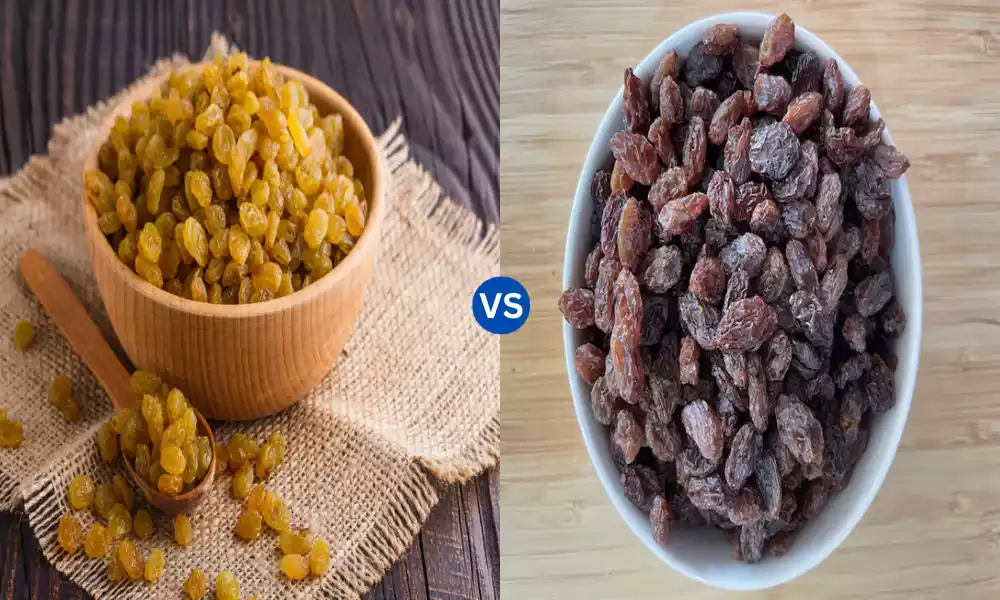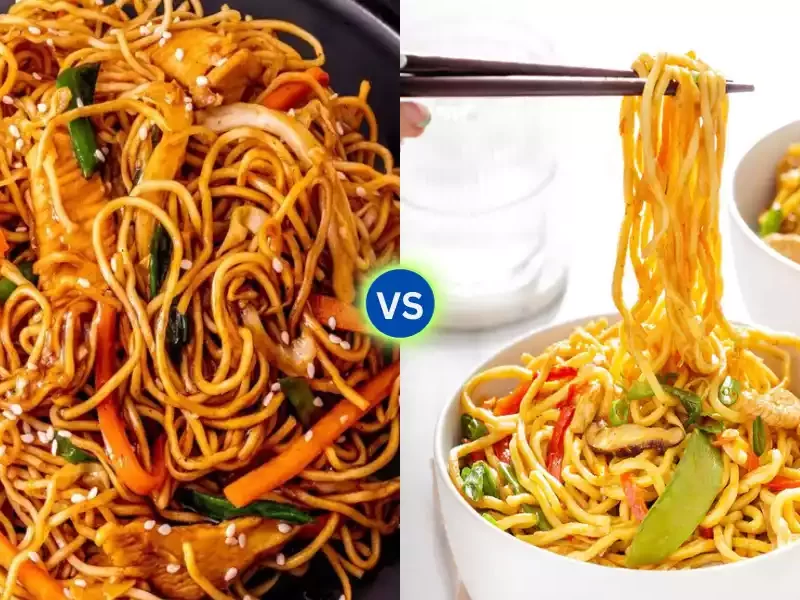Raisins and Sultanas are both cherished dried fruits that have graced kitchens and dishes around the world for centuries. Derived from different varieties of grapes, these sun-dried or mechanically dried delights are not just sweet additions to a multitude of culinary dishes but are also packed with nutrients. While they often seem interchangeable in many recipes, subtle differences in taste, texture, and origin distinguish one from the other. We will delve into these differences, offering clarity on what sets raisins and sultanas apart.
Definition of Raisins
Raisins are dried grapes. They are produced by removing the moisture from grapes through either sun drying, shade drying, or mechanical drying processes. This dehydration concentrates the sugars and other nutrients in the grapes, resulting in a sweet, chewy, and wrinkled product. Raisins can be made from various grape varieties, leading to differences in size, color, and flavor. They are consumed worldwide as a snack or used as an ingredient in a wide range of culinary dishes, from baked goods to savory recipes.
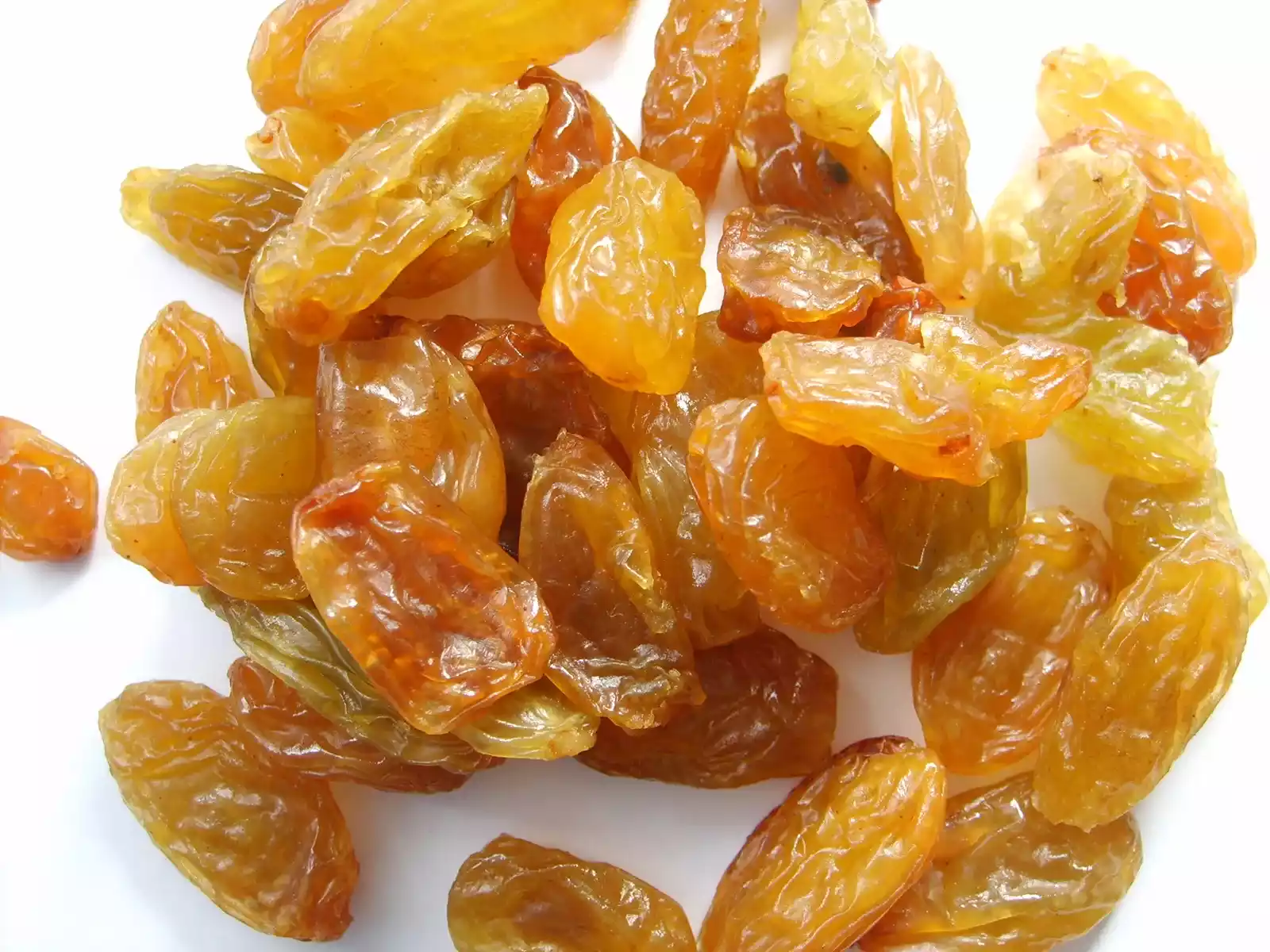
Definition of Sultanas
Sultanas are dried, seedless grapes derived specifically from the Sultana grape variety. They typically have a golden-yellow hue, and due to certain drying processes and treatments, they are often plumper and sweeter than many other raisin types. Sultanas are commonly treated with sulfur dioxide to preserve their light color. They are popularly consumed in various regions and are used in culinary applications both as a standalone snack and as an ingredient in various dishes.
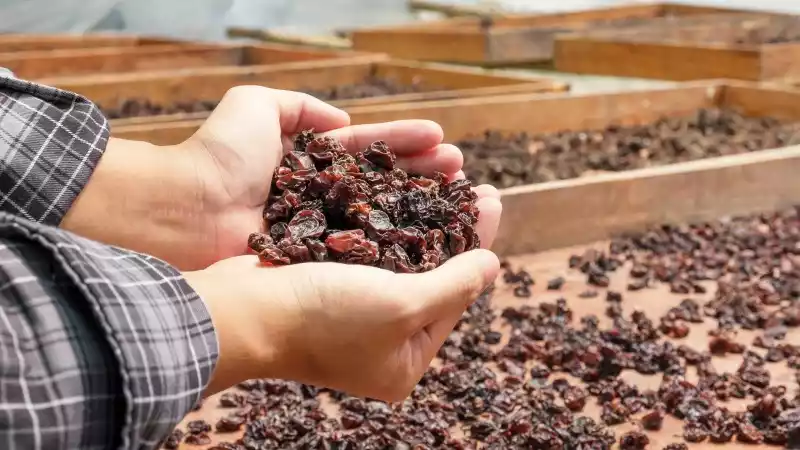
Origin and History
Origin and History of Raisins and Sultanas
Raisins:
Raisins have an ancient history, with evidence of their consumption and trade dating back over 6,000 years. They were found in tombs of Egyptian pharaohs, signifying their value in ancient civilizations. Originally, raisins were developed in the Middle East and Mediterranean regions. Ancient Persians and Egyptians cultivated raisins, not just as a food item but also as a commodity in trade. They were revered both for their sweet taste and their preservative-free long shelf life. As trade routes expanded, the popularity of raisins spread to ancient Greece and Rome, where they were given as prizes in sporting events, used as barter currency, and integrated into various dishes.
Sultanas:
Sultanas, also known as golden raisins in some parts of the world, have origins linked closely with the Ottoman Empire, which includes modern-day Turkey. The name “sultana” is derived from the title “Sultan”, hinting at its noble status among dried fruits. While they have a similar antiquity to raisins, sultanas have been primarily associated with Turkish and Middle Eastern cuisines. Sultanas are prepared from special seedless grapes, often referred to as ‘Sultana grapes’. Over time, as their popularity grew, cultivation spread from Turkey to other parts of the world, including Australia and the US.
As the world became more interconnected through trade and exploration, both raisins and sultanas found their way to new regions, integrating into diverse culinary traditions and becoming the global pantry staples they are today.
Comparison Table of Raisins and Sultanas
Below the comparison table of raisins and sultanas:
| Criteria | Raisins | Sultanas |
|---|---|---|
| Origin Grape | Various grape varieties, often from the Thompson Seedless grape. | Specifically from the Sultana grape variety. |
| Color | Typically dark brown or black, though can vary based on drying method. | Golden-yellow, lighter in color. |
| Drying Process | Sun drying, shade drying, or mechanical drying. | Often dried in controlled environments; may be treated with sulfur dioxide to retain color. |
| Texture | Can be chewy and dry; texture varies based on the type of grape and drying method. | Generally plumper and juicier than many other raisin types. |
| Taste | Sweet, with a deeper flavor; can have a slightly tangy note. | Sweeter and often milder in flavor compared to many raisins. |
| Size | Size varies based on grape variety. | Typically medium-sized, though size can vary slightly. |
| Sulfur Treatment | Some varieties, like golden raisins, are treated with sulfur dioxide. | Commonly treated with sulfur dioxide to maintain their light color. |
| Primary Regions | Grown and produced worldwide, with major producers like the USA, Turkey, and Iran. | Originally linked to Turkey and Middle Eastern regions, but now grown in various countries. |
| Culinary Uses | Used in a broad range of dishes, both savory and sweet. | Popular in both savory and sweet dishes, often used in baked goods and Mediterranean dishes. |
| Nutritional Profile | Rich in natural sugars, fiber, vitamins, and minerals. | Similar to raisins but can vary slightly based on treatment and grape variety. |
This table provides a general overview. There can be overlaps in characteristics between raisins and sultanas based on specific varieties and production methods.
Nutritional Profiles
Nutritional Profiles of Raisins and Sultanas
Both raisins and sultanas are dense sources of energy due to their concentrated sugar content. They provide an array of essential nutrients, though there might be slight variances in their nutritional profiles based on the grape variety and the processing method. Here’s a comparative overview:
Raisins:
- Calories: Raisins contain about 300-325 calories per 100 grams.
- Carbohydrates: They are primarily made up of carbohydrates, predominantly sugars, with around 79 grams per 100 grams.
- Dietary Fiber: Raisins provide about 3.7 grams of dietary fiber per 100 grams.
- Protein: They contain around 3.1 grams of protein per 100 grams.
- Fat: Raisins have a low fat content, approximately 0.5 grams per 100 grams.
- Vitamins: They are a good source of B-vitamins, especially B6, and also contain small amounts of vitamin C, vitamin K, and vitamin E.
- Minerals: Raisins are rich in potassium and also provide calcium, magnesium, phosphorus, iron, and zinc.
- Antioxidants: They contain various antioxidants, including phenols and flavonoids.
Sultanas:
- Calories: Sultanas have approximately 290-320 calories per 100 grams.
- Carbohydrates: Like raisins, they are primarily composed of carbohydrates, with about 77 grams of sugars per 100 grams.
- Dietary Fiber: Sultanas offer around 3.3 grams of dietary fiber per 100 grams.
- Protein: They provide about 2.9 grams of protein per 100 grams.
- Fat: Sultanas also have minimal fat, around 0.4 grams per 100 grams.
- Vitamins: They are rich in B-vitamins, with trace amounts of vitamin C, vitamin K, and vitamin E.
- Minerals: Sultanas are a good source of potassium, magnesium, and iron, with smaller amounts of calcium, phosphorus, and zinc.
- Antioxidants: Like raisins, sultanas are packed with antioxidants, though the specific compounds can vary based on the grape variety and processing.
The nutritional values mentioned above are approximate and can vary based on the specific variety, growing conditions, and processing methods. It’s always a good idea to check the packaging or specific product details for precise nutritional information.
Both raisins and sultanas are healthful additions to the diet when consumed in moderation due to their high sugar content. They can provide quick energy, essential nutrients, and beneficial antioxidants.
Health Benefits
Both raisins and sultanas offer a plethora of health benefits, owing to their rich nutritional profiles. While many of their benefits overlap due to their similarities, let’s dive into the advantages of including these dried fruits in one’s diet.
Health Benefits of Raisins and Sultanas:
- Digestive Health: The dietary fiber in both raisins and sultanas aids in digestion. They can act as natural laxatives when consumed in moderate amounts, helping to alleviate constipation.
- Bone Health: Raisins are a good source of calcium, which is essential for bone health. Additionally, they contain boron, a trace mineral vital for bone formation and calcium absorption.
- Energy Boost: Due to their high natural sugar content, both raisins and sultanas offer a quick source of energy, making them excellent snacks before or after workouts.
- Heart Health: Both raisins and sultanas have potassium, which can help reduce hypertension by counteracting the effects of sodium and relaxing blood vessels.
- Antioxidant Properties: Raisins and sultanas are rich in antioxidants, which help combat oxidative stress. Antioxidants like phenols and flavonoids present in these dried fruits can neutralize harmful free radicals in the body.
- Anti-inflammatory Properties: Some studies suggest that raisins have anti-inflammatory benefits, which can potentially help combat chronic diseases.
- Dental Health: Surprisingly, despite their sweetness, raisins contain phytochemicals like oleanolic acid that may benefit oral health by inhibiting the growth of harmful bacteria in the mouth, thus potentially preventing cavities.
- Iron Source: Raisins are a good source of iron, which can be beneficial for individuals with anemia or those looking to boost their overall iron intake.
- Weight Management: While raisins and sultanas are calorie-dense, their fiber content can provide a feeling of fullness and satiety, potentially helping with weight management when consumed in moderation.
- Enhanced Immunity: The vitamins and minerals in raisins and sultanas can support immune function. Regular consumption might help bolster the body’s defenses against common illnesses.
- Eye Health: Raisins contain polyphenolic phytonutrients that might have protective effects on the eyes, potentially offering protection from age-related macular degeneration.
Precautions:
While raisins and sultanas have many health benefits, it’s essential to consume them in moderation due to their high sugar and calorie content. Overconsumption can lead to excessive calorie intake and potential dental issues. For individuals with fructose intolerance, excessive consumption might lead to digestive problems. It’s also vital to be aware of the potential for added sugars or preservatives in some commercially available products.
As with any dietary change or introduction, it’s a good practice to consult with a healthcare professional or nutritionist to ensure the choice aligns with individual health needs.
Culinary Uses
Raisins and sultanas have long been cherished in culinary traditions around the world. Their sweet, concentrated flavor and chewy texture make them versatile ingredients suitable for both savory and sweet dishes. Here’s an overview of their culinary uses:
Culinary Uses of Raisins:
- Baking: Raisins are a classic ingredient in baked goods like cookies, muffins, bread, and pastries. Think oatmeal raisin cookies or cinnamon raisin bread.
- Breakfast: They can be sprinkled over cereal, oatmeal, or yogurt to add natural sweetness and texture.
- Rice and Grain Dishes: Raisins are often added to pilafs, biryanis, and other rice or grain dishes to provide a sweet contrast to savory flavors.
- Salads: They can be mixed into salads to provide a burst of sweetness. Popular salads with raisins include Waldorf salad and carrot-raisin salad.
- Sauces and Chutneys: Raisins can be simmered in sauces or chutneys to add depth of flavor and a touch of sweetness.
- Stuffings: Raisins are frequently included in stuffings for roasted meats, particularly poultry.
- Snacking: Raisins can be eaten on their own or combined with nuts and seeds for a nutritious trail mix.
- Desserts: They can be used in puddings, ice creams, and other desserts for added flavor and texture.
Culinary Uses of Sultanas:
- Baking: Like raisins, sultanas are popular in baked goods, especially in traditional British recipes like scones or teacakes.
- Breakfast: Sultanas can be added to muesli, granola, or porridge for a sweet start to the day.
- Couscous and Grain Dishes: Their sweet and juicy nature complements savory grain dishes, particularly in Mediterranean and Middle Eastern cuisines.
- Salads: They can provide a sweet balance in salads, often paired with tangy cheeses or toasted nuts.
- Desserts: Sultanas are used in traditional desserts like bread and butter pudding or rice pudding.
- Tagines and Stews: Their sweetness complements the savory and spicy flavors in North African dishes like tagines.
- Snacking: Just like raisins, sultanas can be enjoyed as a standalone snack or mixed into a nut and dried fruit blend.
- Cooking with Wine or Spirits: Sultanas can be soaked in rum, brandy, or other spirits and then used in recipes to infuse more depth and flavor.
Both raisins and sultanas can be rehydrated before use by soaking them in water, juice, or other liquids. This process plumps them up, enhancing their juiciness and tenderness.
Common Misconceptions
Raisins and sultanas, while popular, are often subjects of misconceptions. Let’s clear up some of the common misunderstandings surrounding these dried fruits:
-
- They are the Same Thing: While both raisins and sultanas come from dried grapes, they originate from different grape varieties. Raisins typically come from larger, darker grapes, while sultanas are derived from smaller, seedless, and lighter-colored grapes.
- All Dried Grapes are Raisins: This misconception is prevalent, especially in regions where the term “raisin” is used more generically for dried grapes. In fact, apart from raisins and sultanas, there’s another variety called “currants” which are dried from Black Corinth grapes.
- Natural Sugar Content Equals Added Sugar: The sweetness in raisins and sultanas comes from natural sugars present in grapes. However, some people mistakenly believe that these dried fruits have added sugars. While it’s true some brands might add sweeteners or preservatives, it’s not a given. Always check the packaging to be sure.
- They Are Bad for Your Teeth: While it’s true that the sticky nature of raisins and sultanas can adhere to teeth, which in prolonged conditions might promote cavities, they also contain phytochemicals that can inhibit the growth of oral bacteria associated with cavities and gum disease.
- Lack of Nutritional Value: Some believe that since raisins and sultanas are small and sweet, they might not offer much nutritionally. However, they are packed with energy, fiber, vitamins, and minerals.
- They Contain High Amounts of Fat: Given their calorie content, some might assume that raisins and sultanas are high in fats. In reality, most of their calorie content comes from natural sugars; their fat content is minimal.
- All Raisins and Sultanas are Sulfite-Free: Sulfites are sometimes added to sultanas (and occasionally raisins) to preserve their light color. While many products are sulfite-free, those with sensitivities should always check labels. A reaction to sulfites might manifest as skin rashes, itching, or respiratory symptoms.
- Darker Raisins are of Lower Quality: The color of raisins can vary based on the grape variety and processing method. Darker color doesn’t necessarily indicate inferior quality; it might simply be a characteristic of the grape variety.
- Size Indicates Quality: Some might believe larger raisins or sultanas are of better quality. Size can vary based on the grape type, and it isn’t a direct indicator of quality or taste.
Understanding these misconceptions helps in making informed choices and appreciating the distinct characteristics and benefits of both raisins and sultanas.
Storage and Preservation
Proper storage and preservation of raisins and sultanas are essential to maintain their freshness, flavor, and nutritional value. Given their low moisture content, they have a relatively long shelf life, but specific storage practices can further extend their usability.
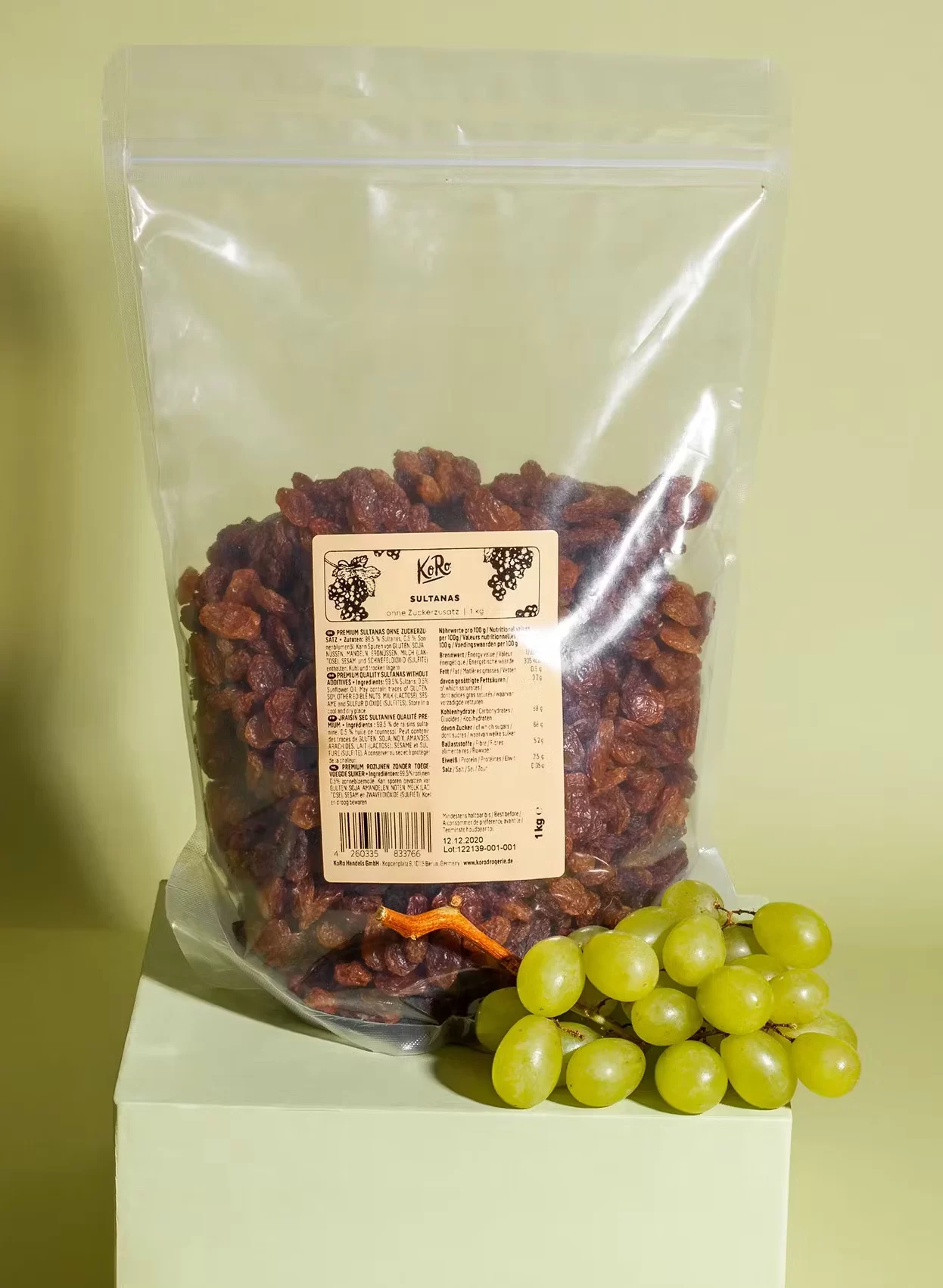
Here’s how to store and preserve them:
Storage:
- Short-term Storage: For everyday use, store raisins and sultanas in a cool, dry place in an airtight container. This helps maintain their freshness and prevents them from becoming too dry or hard.
- Refrigeration: If you live in a very humid area or plan to store them for more than a few months, consider refrigerating them in a sealed container. This will help maintain their moisture and prevent crystallization of the sugars on their surface.
- Freezing: For long-term storage (more than a year), you can freeze raisins and sultanas. Place them in airtight freezer bags, removing as much air as possible. They will remain relatively soft even when frozen, so you can take out and use the desired amount without defrosting the entire bag.
Preservation:
- Check for Moisture: Before storing, ensure that there’s no external moisture on the raisins or sultanas. Any moisture can promote mold growth.
- Avoid Mixed Storage: Don’t store raisins or sultanas with items that have strong odors (like garlic or onions), as they can absorb these smells.
- Sulfites: Some commercially available sultanas might be treated with sulfites to retain their light color. If you’re sensitive to sulfites, always check the label and choose products that are labeled as “unsulfured.”
- Reviving Dry Raisins or Sultanas: If they’ve lost their moisture and become too hard, you can rehydrate them. Soak in hot water for a few minutes, then drain and pat dry. You can also steam them for a few minutes.
- Watch for Contaminants: Before storing large quantities, check for any debris or small stones that might be mixed in with the dried fruits.
- Bulk Purchases: If you buy raisins or sultanas in bulk, consider repackaging them into smaller airtight containers. This way, each time you need some, you can open a smaller container without exposing the entire batch to air and potential contaminants.
Shelf Life:
- Pantry: In a cool, dry place, raisins and sultanas can last several months.
- Refrigerator: When stored in the fridge, they can last up to a year.
- Freezer: In a deep freezer, they can last for over a year.
Regularly checking your stored raisins and sultanas for any signs of spoilage (like mold or off odors) is essential. If they appear moldy, discolored, or smell off, it’s best to discard them. Proper storage and routine checks ensure you enjoy their flavor and health benefits for a more extended period.
Potential Risks and Allergies
Raisins and sultanas are generally safe for most people to consume. Like all foods, there are potential risks and allergies associated with them that some individuals might need to be aware of:
-
- Sulfites: Some raisins and sultanas, particularly those that are commercially processed, might be treated with sulfites to maintain color and prolong shelf life. Sulfites can trigger allergic reactions in sensitive individuals. Symptoms can range from mild (itching, stomach cramps) to more severe reactions like difficulty breathing. If you’re sensitive to sulfites, always choose products labeled as “unsulfured” or “sulfite-free.”
- Fructose Intolerance: Raisins and sultanas are rich in fructose, a natural sugar. Individuals with hereditary fructose intolerance or fructose malabsorption should limit or avoid consuming these dried fruits, as they can cause digestive symptoms like bloating, gas, and diarrhea.
- Choking Hazard: Their small, chewy nature can pose a choking risk, especially for young children. Always supervise children when they’re eating and consider chopping the raisins or sultanas into smaller pieces.
- Tooth Decay: Despite containing certain compounds that might fight oral bacteria, the sticky texture of raisins and sultanas can adhere to teeth. This can potentially promote tooth decay if good oral hygiene isn’t maintained. It’s advisable to rinse your mouth or brush your teeth after consuming these dried fruits.
- Caloric Density: Because of their natural sugar content, raisins and sultanas are calorie-dense. Consuming them in large quantities without adjusting total caloric intake or increasing physical activity can contribute to weight gain.
- Pesticide Residue: Grapes, from which raisins and sultanas are made, are sometimes grown with the help of pesticides. If not properly processed or washed, these chemicals can remain on the dried fruits. Opting for organic raisins or sultanas can help reduce the risk of pesticide exposure.
- Gastrointestinal Blockage in Pets: It’s crucial to mention that grapes and their dried forms (raisins and sultanas) are toxic to dogs and possibly cats. Consumption can lead to kidney failure in pets. Always keep these dried fruits away from pets and seek immediate veterinary care if ingestion occurs.
- Interaction with Medications: Although rare, raisins might interact with certain medications due to their vitamin K content. People on anticoagulant drugs should consult their doctor about their diet.
- Mold and Contaminants: Improper storage or buying from unreliable sources can lead to mold growth or contamination in raisins and sultanas, which can cause health issues if consumed.
As with any food, moderation is key. If you suspect an allergy or sensitivity to raisins or sultanas, it’s always best to consult with a healthcare professional.
Economic Impact
The economic impact of raisins and sultanas extends from local communities to global trade markets. As a significant commodity, especially in specific regions, the cultivation, processing, and export of these dried fruits can have profound implications.
- Major Producers: The United States (primarily California), Turkey, and Iran are among the world’s top raisin producers. Their economies, especially certain regions within these countries, are heavily dependent on grape and raisin production.
- Employment: The raisin and sultana industry creates employment opportunities in various sectors, including farming, processing, packaging, and exporting. It offers jobs for farmworkers, factory workers, transportation personnel, and more.
- Export and Trade: Raisins and sultanas are significant export items for top-producing countries. They generate substantial foreign exchange revenue, which can influence trade balances. Moreover, international trade agreements, tariffs, and regulations can significantly impact the profitability and volume of raisin exports.
- Local Economies: In regions where grape farming for raisins is predominant, the local economy can be greatly influenced by raisin prices, harvest yields, and demand. For instance, a poor harvest due to adverse weather can have ripple effects on the local economy.
- Price Fluctuations: The price of raisins and sultanas can vary based on factors like global demand, harvest quality, international relations (trade barriers or sanctions), and production costs. Price volatility can affect farmers’ incomes and economic stability in producing regions.
- Innovation and Technology: The economic viability of the raisin industry pushes for innovation. Investments in technology, whether for improved irrigation, sustainable farming practices, or efficient processing methods, can lead to job creation and skill development.
- Diversification: Over-reliance on a single crop, like grapes for raisin production, can be risky. Economic pressures and uncertainties might push regions or countries to diversify their agricultural production or seek value-added products to mitigate risks.
- Tourism: In some regions, vineyards and raisin production facilities attract tourists. This agritourism can be an additional source of revenue, benefiting local businesses like restaurants, hotels, and tour operators.
- Infrastructure Development: Significant raisin-producing regions often see infrastructure development, like roads, storage facilities, and processing plants, to support the industry. Such infrastructure can benefit other sectors and the community at large.
- Environmental Costs: While there are economic gains from raisin production, there are also environmental costs, like excessive water use or pesticide runoff. Addressing these issues might require economic investments, either by the industry itself or through government interventions.
- Cultural Significance: Raisins and sultanas have cultural and traditional significance in many regions, influencing local festivals, culinary traditions, and even art. This cultural aspect can have indirect economic implications, especially in tourism and local trade.
- Market Competition: As global markets become more interconnected, raisin producers face competition from other regions or substitutes. Adapting to market dynamics, whether through branding, quality assurance, or diversification, can have economic consequences.
The economic impact of raisins and sultanas is multifaceted, spanning local communities to international markets. As with any significant agricultural commodity, the interplay between production, demand, and external factors determines the overall economic footprint of the industry.
Sustainability and Environmental Concerns
The cultivation and processing of grapes into raisins or sultanas, like many agricultural practices, have various environmental and sustainability implications. Awareness of these concerns can help consumers make more informed decisions when purchasing these dried fruits.
- Water Consumption: Vineyards, especially those in regions like California (a significant producer of raisins), can be water-intensive. The central valley of California, for instance, has faced water shortages and has had to deal with issues related to over-extraction of groundwater. Efficient water management is crucial to ensure long-term viability of grape cultivation in these areas.
- Pesticides and Chemicals: Grapes are among the crops that can have high pesticide residues if not grown organically or sustainably. Over-reliance on pesticides can harm local ecosystems, contaminate groundwater, and impact the health of farmworkers and consumers.
- Land Use and Soil Health: The conversion of natural habitats into agricultural land for vineyards can impact biodiversity. Moreover, continuous cultivation without sustainable practices can lead to soil degradation, erosion, and decreased soil fertility.
- Packaging: Raisins and sultanas are often packaged in plastic bags or boxes, contributing to plastic waste. Brands that employ eco-friendly, recyclable, or biodegradable packaging can be more sustainable in this respect.
- Carbon Footprint: Transportation of raisins and sultanas, especially when shipped internationally, contributes to their carbon footprint. Buying local or from closer sources, when possible, can help reduce this impact.
- Labor Concerns: The harvesting of grapes and processing into raisins can be labor-intensive. In some regions, there have been concerns about labor rights, fair wages, and working conditions for farmworkers. Ethically-sourced raisins and sultanas can help address these concerns.
- Waste Management: The grape stems and other by-products from the raisin production process need to be managed and disposed of properly. Some vineyards and processing plants use these by-products for composting or as feed, promoting a circular economy.
- Monoculture Practices: Like other crops, large scale grape farming often leans towards monoculture, which can make crops more susceptible to diseases and pests. This, in turn, can lead to increased pesticide use.
Making Sustainable Choices:
- Certifications: Look for raisins or sultanas that have certifications like Organic, Fair Trade, or Rainforest Alliance. These certifications can indicate adherence to specific environmental and social standards.
- Buy Local: If available, buying local products can reduce transportation-related environmental impacts.
- Bulk Purchasing: Buying in bulk can reduce the amount of packaging waste. However, ensure you have proper storage to prevent spoilage.
- Educate and Advocate: Being informed about the environmental issues related to raisin production can help you advocate for better practices within the industry or support legislation that promotes sustainable agriculture.
- Support Sustainable Brands: Brands that invest in water-saving technologies, sustainable farming practices, and ethical labor practices deserve consumer support.
As with all agricultural products, the balance between demand, production practices, and environmental sustainability is delicate. Conscious consumer choices can influence the industry towards more sustainable practices.
Interesting Facts and Trivia
Raisins and sultanas, while seemingly simple dried fruits, have a rich history and numerous intriguing aspects. Here are some interesting facts and trivia:
- Ancient Delicacy: Raisins were consumed by ancient civilizations, including the Egyptians, Greeks, and Romans. They were even found in tombs of Egyptian pharaohs, showcasing their value and importance.
- Currency?: In ancient times, raisins were so valuable that they were used as currency and also given as prizes in sporting events!
- Longevity: Given the right conditions, raisins can last a long time. Some raisins found in archaeological digs were thousands of years old and still recognizable.
- Grape Tonnes: It takes about 4.5 pounds (2 kilograms) of grapes to produce 1 pound (450 grams) of raisins.
- Raisin Capital: Fresno, California, claims to be the “Raisin Capital of the World.” The San Joaquin Valley in California produces a significant portion of the world’s raisin supply.
- Drying Process: Raisins can be sun-dried, shade-dried, or mechanically dried. Sun-drying is the most traditional method and can take up to three weeks.
- Grape Variety Matters: Not all grapes can become raisins. Specific varieties like Thompson Seedless, Flame Seedless, and Black Corinth are favored for raisin production.
- National Raisin Day: April 30th is celebrated as National Raisin Day in the United States.
- Golden Raisins: The golden hue of some raisins is due to the treatment with sulfur dioxide, which prevents them from darkening during drying.
- Raisins in Space: Raisins were among the foods taken aboard Skylab, a space station operated by NASA in the 1970s, as a part of the astronauts’ diet.
- Natural Sweetener: Raisins can act as a natural sweetener in many dishes, reducing the need for added sugars.
- Raisin Meditation: Some mindfulness exercises involve using a raisin. Participants are asked to spend several minutes observing, touching, smelling, tasting, and slowly eating a single raisin, emphasizing the experience of being in the moment.
- Culinary Cultures: Sultanas, especially, play an integral role in cuisines of the Middle East, Mediterranean, and South Asia. They are often found in dishes ranging from pilafs to pastries.
- Record-Setting: The world’s largest raisin was recorded in 2003, weighing 24.7 grams. That’s about eight times the weight of an average raisin!
- Literary Mention: Raisins are mentioned in various literary works, from the Bible to Shakespeare’s works, highlighting their historical and cultural significance.
These facts and trivia showcase the fascinating journey of raisins and sultanas from humble dried fruits to globally celebrated delicacies with historical, cultural, and economic significance.
Conclusion
Raisins and sultanas, while often used interchangeably, are distinct in their origins, processing methods, and flavor profiles. Originating from different grape varieties and undergoing unique drying processes, these dried fruits have carved their own niches in culinary traditions around the world. Beyond their sweet, tangy flavors, they offer notable health benefits and have a rich historical and cultural backdrop.
Like all agricultural products, their production comes with economic, environmental, and sustainability considerations. As delicious and versatile pantry staples, understanding the nuances between raisins and sultanas enriches our appreciation of these timeless treats.

